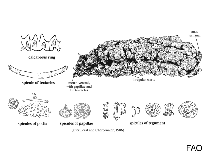Apostichopus californicus (Stimpson, 1857)
California sea cucumber| Native range | All suitable habitat | Point map | Year 2050 |

|
| This map was computer-generated and has not yet been reviewed. |
| Apostichopus californicus AquaMaps Data sources: GBIF OBIS |
Google image | No image available for this species;
drawing shows typical species in Stichopodidae.
Classification / Names Common names | Synonyms | CoL | ITIS | WoRMS
Holothuroidea | Synallactida | Stichopodidae
Environment: milieu / climate zone / depth range / distribution range Ecology
Benthic; depth range 0 - 90 m (Ref. 865). Temperate
Distribution Countries | FAO areas | Ecosystems | Occurrences | Introductions
Eastern Pacific.
Length at first maturity / Size / Weight / Age
Maturity: Lm ? range ? - ? cm Max length : 7.5 cm TL male/unsexed; (Ref. 865)
Life cycle and mating behavior Maturity | Reproduction | Spawning | Eggs | Fecundity | Larvae
Main reference
References | Coordinator | Collaborators
Lambert, P. 2000 Sea stars of British Columbia, Southeast Alaska and Puget Sound. Canada: UBC Press. 186 p. (Ref. 93256)
IUCN Red List Status
(Ref. 130435: Version 2025-1)
CITES status (Ref. 108899)
CMS (Ref. 116361)
Threat to humans
Human uses
| FishSource |
Tools
More information
Max. ages / sizes
Length-weight rel.
Length-length rel.
Length-frequencies
Mass conversion
Abundance
Internet sources
BHL | BOLD Systems | CISTI | DiscoverLife | FAO(Publication : search) | Fishipedia | GenBank (genome, nucleotide) | GloBI | Gomexsi | Google Books | Google Scholar | Google | PubMed | Tree of Life | Wikipedia (Go, Search) | Zoological Record



